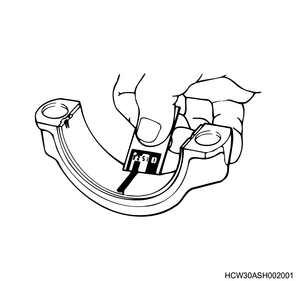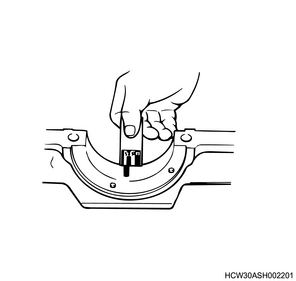1. Using the PLASTIGAUGE
| PLASTIGAUGE type and measurable range |
|
| Type |
Measurable range |
| PG-1 (Green) |
0.025 - 0.076 mm {0.000984 - 0.002992 in} |
| PR-1 (Red) |
0.051 - 0.152 mm {0.002008 - 0.005984 in} |
| PB-1 (Blue) |
0.102 - 0.229 mm {0.004016 - 0.009016 in} |
Method for measuring clearance between connecting rod bearing and crank pin
Clean the connecting rod and bearing, and assemble to the connecting rod.
Cut the PLASTIGAUGE to the width of the crank pin and lay it parallel while avoiding the crank pin oil hole.
Align the marking on the connecting rod with the marking on the cap, and assemble to the crank pin. Apply engine oil to the threaded portion and seating surface of the tightening bolt. Tighten alternately so that the cap is tightened to the specified torque.
Gently remove the cap and connecting rod, and measure the width of the flattened PLASTIGAUGE using the scale printed on the packaging.
Caution
- Do not move the connecting rod when using PLASTIGAUGE.


Method for measuring clearance between crank bearing and crank journal
Clean the bearing, as well as the cylinder block and crankcase bearing mounting surfaces, and assemble to the cylinder block and crankcase.
Gently place the crankshaft on the cylinder block, and settle it by turning it approximately 30°.
Cut the PLASTIGAUGE to the width of the crank journal and lay it parallel while avoiding the journal oil hole.
Gently place the crankcase on the cylinder block, and apply engine oil to the threaded portion and seating surface of the tightening bolt. Tighten the bolts in order to the specified torque.
Gently remove the crankcase, and measure the width of the flattened PLASTIGAUGE using the scale printed on the packaging.
Caution
- Do not rotate the crankshaft when using PLASTIGAUGE.

